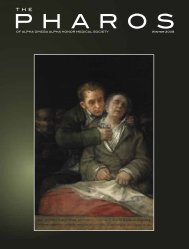Download The Pharos Winter 2011 Edition - Alpha Omega Alpha
Download The Pharos Winter 2011 Edition - Alpha Omega Alpha
Download The Pharos Winter 2011 Edition - Alpha Omega Alpha
You also want an ePaper? Increase the reach of your titles
YUMPU automatically turns print PDFs into web optimized ePapers that Google loves.
<strong>The</strong> author is chief resident in<br />
Internal Medicine at the Yale<br />
Primary Care Residency Program.<br />
From its advent in September<br />
2006 until its removal from the<br />
market in October 2007, inhaled<br />
insulin for diabetes mellitus<br />
represented the first effective alternative<br />
to subcutaneous injections in<br />
more than eighty years. Aside from<br />
its administration modality, Exubera<br />
(Insulin Human [rDNA origin]) also<br />
transformed dosage labeling from<br />
the traditional insulin “unit” into<br />
milligrams. While this conversion<br />
may have appeared novel, it actually<br />
harked back to a time early in insulin<br />
therapy’s history. Indeed, defining insulin<br />
quantity in terms of milligrams<br />
sits at the heart of post-World War I<br />
efforts to ensure the new product’s<br />
safety and reliability. <strong>The</strong>se early attempts<br />
at its international standardization<br />
laid the foundation on which<br />
insulin dosage is still based today.<br />
Frederick Grant Banting.<br />
Courtesy of the National Library of Medicine.<br />
Producing an insulin extract<br />
In the autumn of 1920, Canadian<br />
surgeon Frederick Grant Banting<br />
scribbled,<br />
Diabetus<br />
Ligate pancreatic ducts of<br />
dog. Keep dogs alive till acini<br />
degenerate leaving Islets.<br />
Try to isolate the internal secretion<br />
of these to relieve glycosurea<br />
[sugar in the urine]. 1p50<br />
In this short note, Banting<br />
outlined how he would<br />
find the quintessentialtreatment<br />
for a disease he could not even spell.<br />
Over the next year, Banting worked<br />
in the University of Toronto physiology<br />
laboratory of Professor J. J. R.<br />
Macleod. With the help of graduate<br />
students Charles Best and Clark<br />
Noble, he purified his first insulin extract<br />
from the degenerating pancreases<br />
of canine subjects and showed it<br />
could transiently reduce the animals’<br />
blood sugar.<br />
Banting presented his findings to<br />
the American Physiological Society<br />
conference in December 1921. Among<br />
attendees expressing interest in extract<br />
production was George H. A.<br />
Clowes, research director for the Eli<br />
Lilly Pharmaceutical Company of<br />
Indianapolis. Though his offer was<br />
initially turned down, it caused the<br />
researchers to patent their process<br />
to maintain their control over the<br />
integrity of the extract’s manufacture<br />
and purification. <strong>The</strong> University of<br />
Toronto’s Board of Governors subsequently<br />
licensed the process to Lilly’s<br />
laboratories. 1 American production<br />
supplemented the relatively meager<br />
yields at Toronto’s own Connaught<br />
Antitoxin Laboratories, supplying<br />
a burgeoning international market<br />
with insulin therapy.<br />
To oversee insulin’s future licensing<br />
and distribution, the Board<br />
of Governors organized Toronto’s<br />
Insulin Committee (IC) in 1922. One<br />
of its first actions was to offer patent<br />
rights to the British Medical Research<br />
Council (MRC), thus giving Europe<br />
its first access to insulin. <strong>The</strong> MRC<br />
sent Dr. Henry H. Dale, a department<br />
director at their National<br />
Institute for Medical Research, to<br />
Toronto. Dale quickly recognized the<br />
promise of insulin and suggested the<br />
<strong>The</strong> <strong>Pharos</strong>/<strong>Winter</strong> <strong>2011</strong> 29














